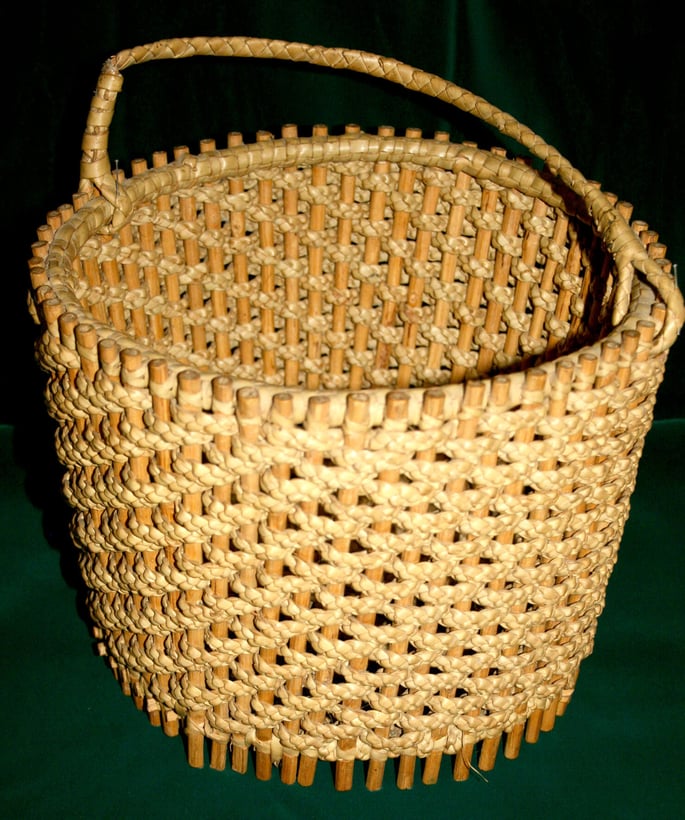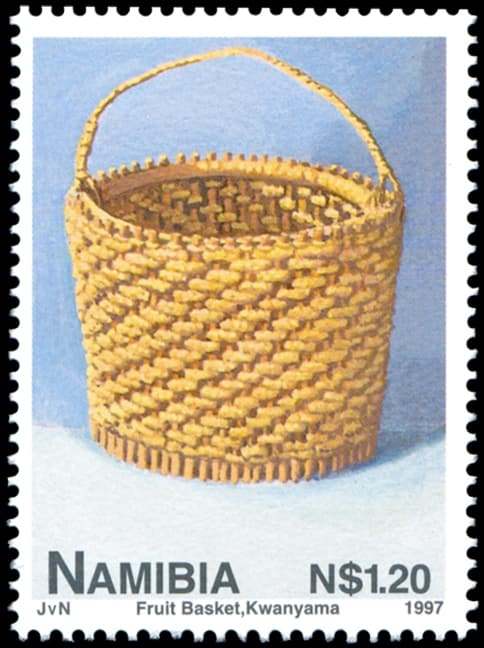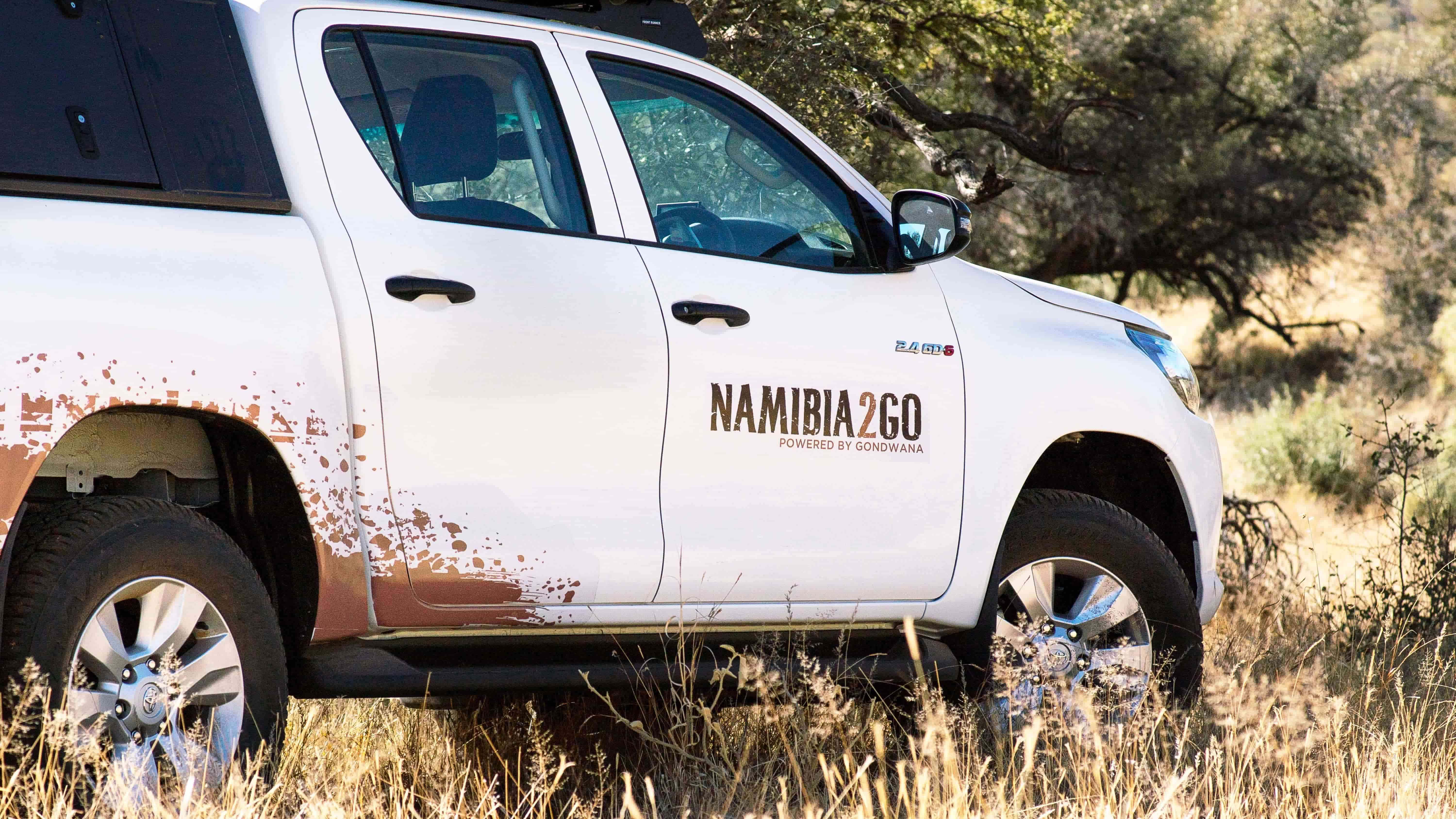Traditionally, the AaWambo were renowned basket makers and used a wide variety of baskets and other woven articles. Before the start of promotion campaigns some thirty years ago, whereby baskets are produced and bought up on a large scale to be sold in the tourist industry, traditionally-made baskets were still of utmost importance for utilitarian purposes. Unfortunately, many of the old baskets are longer made today and can only be viewed in museum collections.
The raw material used for most basketry consists of the young leaves of the fan palm (Hyphaene petersiana). Other materials include grass, as well as wood and bark of various trees and shrubs.
The present-day dominant weaving technique is the coil. The spine of the palm leaf is used for the coil, while the split leaf fiber is used for wrapping. In contrast to all other basket makers, who use an awl to sew the coils together, the AaWambo use an iron needle. Women make all baskets, which formerly ranged from winnowing trays, flour and millet baskets, lidded baskets for dry food or personal belongings, fish baskets, chicken baskets, small powder baskets, etc. Men are responsible for making mats, fishing traps, beer strainers, modern-style hats and grain storage bins.
Formerly the coiling technique was used when manufacturing flat winnowing trays (elilo), truncated cone shaped baskets, referred to as oshimbale, and lidded half-spherical baskets. Apart from these, there were the so-called oshimbaba baskets, which were produced according to the ordinary chequer weave technique. This type of basket was very strong and often used for transporting salt or iron. Men carried two or more of these baskets on a pole over the shoulder. In addition, there were large roughly made twined baskets for temporary use.
Of particular beauty were the former fruit baskets, which were made from thin peeled saplings of Combretum engleri and palm leaf fiber. The walls consisted of some unusual wickerwork with a plaited horizontal element, while the base was sometimes coiled. The baskets had a handle of palm leaf fiber and their height ranged from 13 to 20 cm. René Dickman collected the depicted basket together with another similar basket when he worked as assistant for Major Cocky Hahn in Ovamboland between 1916 and 1921. Later the National Museum of Namibia acquired both baskets. A very similar basket, which is kept by the Museum of the University of Pennsylvania, was collected in Angola in 1930. Lidded rectangular storage baskets of similar design were apparently made through the influence of the Finnish missionaries.
Other woven objects included twined funnel-shaped fishing traps (ondiva), which are still made from Grewia twigs and palm leaf fiber and beer strainers (omhako) made from grass and the saplings and bark of Colophospermum mopane. Crudely woven mats (oyinda) are made according to the chequer weave technique, whereby the palm leaf strands are simply floated one over the other. Hats were not originally known, but became increasingly popular later. Grain storage bins, known as omaanda or omashisha, are made of flexible saplings and bark of Colophospermum mopane. Their inside is plastered with clay and they are provided with a tight-fitting lid. They are generally placed under grass roofs and rest on poles to protect the grain from termites.
Palm leaves, serving as binding material are sometimes treated with dyes to produce colours. Dark brown is obtained by boiling the finely crushed bark of omuve (Berchemia discolor) together with the palm leaves. Orange can be procured either from the fruit of Berchemia discolor or from the root of the so-called ompindi bush. Black is gained from the finely crushed roots of the omudhime bush (Euclea divinorum), while a purple dye is obtained from its fruit. Palm leaves can also be dyed deep red by boiling them together with the finely pounded bark of the omuve tree (Pterocarpus angolensis). Today many colours are obtained from commercial ink diluted in water.







SUBMIT YOUR COMMENT